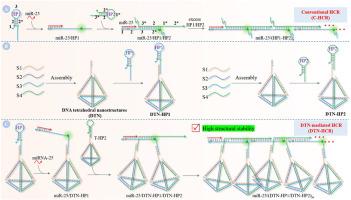当前位置:
X-MOL 学术
›
Anal. Chim. Acta
›
论文详情
Our official English website, www.x-mol.net, welcomes your
feedback! (Note: you will need to create a separate account there.)
Enhanced Stability of Hairpin-Functionalized DNA Tetrahedral Nanostructures for miRNA Detection in Plasma from Ischemic Stroke Patients
Analytica Chimica Acta ( IF 5.7 ) Pub Date : 2024-11-13 , DOI: 10.1016/j.aca.2024.343419 Jiansheng Su, Tingshan Liu, Min Wang, Wansong Xu, Junle Liu, Jianning Lan, Yujuan Chen, Huo Xu, Danhua Guo, Zhongmeng Lai
Analytica Chimica Acta ( IF 5.7 ) Pub Date : 2024-11-13 , DOI: 10.1016/j.aca.2024.343419 Jiansheng Su, Tingshan Liu, Min Wang, Wansong Xu, Junle Liu, Jianning Lan, Yujuan Chen, Huo Xu, Danhua Guo, Zhongmeng Lai

|
The enzyme-free amplification technique using the Hybridization Chain Reaction (HCR) is gaining traction for its efficiency in miRNA analysis. Conventional HCR (C-HCR) with hairpin probes faces challenges due to enzymatic degradation in body fluids, leading to potential false-positive results. This study addresses the critical need for a more reliable method that resists enzymatic breakdown and improves diagnostic accuracy for detecting miRNA related to ischemic stroke. We have developed a novel DNA tetrahedral nanostructures-mediated HCR (DTN-HCR) platform for the precise detection of microRNA-25 (miR-25), a biomarker for ischemic stroke. Incorporating two unique DNA tetrahedral nanostructures with embedded hairpin structures (DTN-HP1 and DTN-HP2), this platform activates upon miR-25 binding, initiating a robust DTN-HCR reaction. This reaction forms extensive DNA tetrahedron clusters that significantly boost the fluorescence signal, enabling detection thresholds as low as 5.4 pM. The method showcases exceptional specificity by distinguishing target miRNA from close analogues and maintains structural integrity against DNase I and fetal bovine serum (FBS), verified through polyacrylamide gel electrophoresis (PAGE). It successfully differentiates ischemic stroke patients from healthy controls by analyzing peripheral blood-derived miRNAs. This study concludes that the DTN-HCR platform substantially enhances the specificity and stability of miRNA detection, marking a significant advancement in non-enzymatic miRNA analysis techniques. With its capability to accurately identify ischemic stroke biomarkers at very low concentrations and its resistance to enzymatic degradation, the DTN-HCR method presents a valuable diagnostic tool for ischemic stroke, potentially improving early detection and monitoring in a clinical environment.
中文翻译:

增强发夹功能化 DNA 四面体纳米结构在缺血性中风患者血浆中检测 miRNA 的稳定性
使用杂交链式反应 (HCR) 的无酶扩增技术因其在 miRNA 分析中的效率而受到关注。由于体液中的酶降解,带有发夹探针的常规 HCR (C-HCR) 面临挑战,导致潜在的假阳性结果。这项研究解决了对一种更可靠方法的迫切需求,该方法可以抵抗酶分解并提高检测缺血性中风相关 miRNA 的诊断准确性。我们开发了一种新型 DNA 四面体纳米结构介导的 HCR (DTN-HCR) 平台,用于精确检测缺血性中风的生物标志物 microRNA-25 (miR-25)。该平台结合了两种独特的 DNA 四面体纳米结构,具有嵌入式发夹结构(DTN-HP1 和 DTN-HP2),在 miR-25 结合时激活,引发稳健的 DTN-HCR 反应。该反应形成广泛的 DNA 四面体簇,显著增强荧光信号,使检测阈值低至 5.4 pM。该方法通过区分靶标 miRNA 和紧密类似物来展示卓越的特异性,并保持对 DNase I 和胎牛血清 (FBS) 的结构完整性,通过聚丙烯酰胺凝胶电泳 (PAGE) 验证。它通过分析外周血来源的 miRNA 成功地区分了缺血性卒中患者和健康对照者。本研究得出结论,DTN-HCR 平台显着提高了 miRNA 检测的特异性和稳定性,标志着非酶 miRNA 分析技术的重大进步。 DTN-HCR 方法能够准确识别极低浓度的缺血性卒中生物标志物,并且对酶降解具有抵抗力,为缺血性卒中提供了一种有价值的诊断工具,有可能改善临床环境中的早期检测和监测。
更新日期:2024-11-13
中文翻译:

增强发夹功能化 DNA 四面体纳米结构在缺血性中风患者血浆中检测 miRNA 的稳定性
使用杂交链式反应 (HCR) 的无酶扩增技术因其在 miRNA 分析中的效率而受到关注。由于体液中的酶降解,带有发夹探针的常规 HCR (C-HCR) 面临挑战,导致潜在的假阳性结果。这项研究解决了对一种更可靠方法的迫切需求,该方法可以抵抗酶分解并提高检测缺血性中风相关 miRNA 的诊断准确性。我们开发了一种新型 DNA 四面体纳米结构介导的 HCR (DTN-HCR) 平台,用于精确检测缺血性中风的生物标志物 microRNA-25 (miR-25)。该平台结合了两种独特的 DNA 四面体纳米结构,具有嵌入式发夹结构(DTN-HP1 和 DTN-HP2),在 miR-25 结合时激活,引发稳健的 DTN-HCR 反应。该反应形成广泛的 DNA 四面体簇,显著增强荧光信号,使检测阈值低至 5.4 pM。该方法通过区分靶标 miRNA 和紧密类似物来展示卓越的特异性,并保持对 DNase I 和胎牛血清 (FBS) 的结构完整性,通过聚丙烯酰胺凝胶电泳 (PAGE) 验证。它通过分析外周血来源的 miRNA 成功地区分了缺血性卒中患者和健康对照者。本研究得出结论,DTN-HCR 平台显着提高了 miRNA 检测的特异性和稳定性,标志着非酶 miRNA 分析技术的重大进步。 DTN-HCR 方法能够准确识别极低浓度的缺血性卒中生物标志物,并且对酶降解具有抵抗力,为缺血性卒中提供了一种有价值的诊断工具,有可能改善临床环境中的早期检测和监测。


















































 京公网安备 11010802027423号
京公网安备 11010802027423号